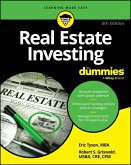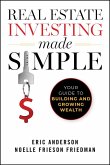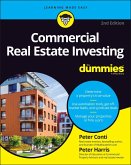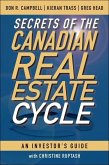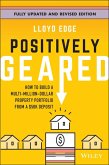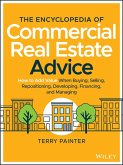Harm Meijer
Real Estate Rules (eBook, ePUB)
The Investor's Guide to Picking Winners and Avoiding Losers in Listed Property
32,99 €
32,99 €
inkl. MwSt.
Sofort per Download lieferbar

0 °P sammeln
32,99 €
Als Download kaufen

32,99 €
inkl. MwSt.
Sofort per Download lieferbar

0 °P sammeln
Jetzt verschenken
Alle Infos zum eBook verschenken
32,99 €
inkl. MwSt.
Sofort per Download lieferbar
Alle Infos zum eBook verschenken

0 °P sammeln
Harm Meijer
Real Estate Rules (eBook, ePUB)
The Investor's Guide to Picking Winners and Avoiding Losers in Listed Property
- Format: ePub
- Merkliste
- Auf die Merkliste
- Bewerten Bewerten
- Teilen
- Produkt teilen
- Produkterinnerung
- Produkterinnerung

Bitte loggen Sie sich zunächst in Ihr Kundenkonto ein oder registrieren Sie sich bei
bücher.de, um das eBook-Abo tolino select nutzen zu können.
Hier können Sie sich einloggen
Hier können Sie sich einloggen
Sie sind bereits eingeloggt. Klicken Sie auf 2. tolino select Abo, um fortzufahren.

Bitte loggen Sie sich zunächst in Ihr Kundenkonto ein oder registrieren Sie sich bei bücher.de, um das eBook-Abo tolino select nutzen zu können.
The incisive guide of how to effectively invest in real estate and REITs
In Real Estate Rules: The Investor's Guide to Picking Winners, Avoiding Losers in Listed Property, celebrated real estate investor Harm Meijer delivers a startlingly insightful and eye-opening roadmap to successful property investment. This book explains the golden rules of investing in European real estate companies, including Real Estate Investment Trusts (REITs). It's full of real-world examples and anecdotes drawn from the author's long and storied career in the industry.
Real Estate Rules contains:
…mehr
- Geräte: eReader
- mit Kopierschutz
- eBook Hilfe
- Größe: 11.99MB
Andere Kunden interessierten sich auch für
![Real Estate Investing For Dummies (eBook, ePUB) Real Estate Investing For Dummies (eBook, ePUB)]() Eric TysonReal Estate Investing For Dummies (eBook, ePUB)17,99 €
Eric TysonReal Estate Investing For Dummies (eBook, ePUB)17,99 €![Real Estate Investing Made Simple (eBook, ePUB) Real Estate Investing Made Simple (eBook, ePUB)]() Eric AndersonReal Estate Investing Made Simple (eBook, ePUB)16,99 €
Eric AndersonReal Estate Investing Made Simple (eBook, ePUB)16,99 €![Commercial Real Estate Investing For Dummies (eBook, ePUB) Commercial Real Estate Investing For Dummies (eBook, ePUB)]() Peter ContiCommercial Real Estate Investing For Dummies (eBook, ePUB)17,99 €
Peter ContiCommercial Real Estate Investing For Dummies (eBook, ePUB)17,99 €![Secrets of the Canadian Real Estate Cycle (eBook, ePUB) Secrets of the Canadian Real Estate Cycle (eBook, ePUB)]() Don R. CampbellSecrets of the Canadian Real Estate Cycle (eBook, ePUB)20,99 €
Don R. CampbellSecrets of the Canadian Real Estate Cycle (eBook, ePUB)20,99 €![Private Markets (eBook, ePUB) Private Markets (eBook, ePUB)]() Tony DavidowPrivate Markets (eBook, ePUB)31,99 €
Tony DavidowPrivate Markets (eBook, ePUB)31,99 €![Positively Geared (eBook, ePUB) Positively Geared (eBook, ePUB)]() Lloyd EdgePositively Geared (eBook, ePUB)17,99 €
Lloyd EdgePositively Geared (eBook, ePUB)17,99 €![The Encyclopedia of Commercial Real Estate Advice (eBook, ePUB) The Encyclopedia of Commercial Real Estate Advice (eBook, ePUB)]() Terry PainterThe Encyclopedia of Commercial Real Estate Advice (eBook, ePUB)33,99 €
Terry PainterThe Encyclopedia of Commercial Real Estate Advice (eBook, ePUB)33,99 €-
-
-
The incisive guide of how to effectively invest in real estate and REITs
In Real Estate Rules: The Investor's Guide to Picking Winners, Avoiding Losers in Listed Property, celebrated real estate investor Harm Meijer delivers a startlingly insightful and eye-opening roadmap to successful property investment. This book explains the golden rules of investing in European real estate companies, including Real Estate Investment Trusts (REITs). It's full of real-world examples and anecdotes drawn from the author's long and storied career in the industry.
Real Estate Rules contains:
You'll also learn why acting on conviction, thorough research, strong relationships, and most importantly, trust are key to achieving lasting success.
Perfect for Real Estate Investment Trust investors, people interested in investing directly in individual properties, and other market participants, Real Estate Rules is also a must-read for anyone involved in the real estate industry looking for an insightful investor perspective on the sector.
In Real Estate Rules: The Investor's Guide to Picking Winners, Avoiding Losers in Listed Property, celebrated real estate investor Harm Meijer delivers a startlingly insightful and eye-opening roadmap to successful property investment. This book explains the golden rules of investing in European real estate companies, including Real Estate Investment Trusts (REITs). It's full of real-world examples and anecdotes drawn from the author's long and storied career in the industry.
Real Estate Rules contains:
- Robust tools for making informed investment decisions and staying clear of the "vicious downward spiral of doom"
- Understanding market cycles and mastering the art of acting contrarian during downturns to maximize your investment
- How macro drivers, central bank moves and government stimuli can be game changers for real estate markets
- Techniques for assessing the management's value creation and its alignment with shareholders
- Insights to ensure a solid capital structure and avoid leverage traps in downturns
- Advice on how to navigate the European stock markets with its unique challenges for Real Estate Investment Trusts
- Real-world case studies illustrating these principles in action, highlighting key lessons for investors
You'll also learn why acting on conviction, thorough research, strong relationships, and most importantly, trust are key to achieving lasting success.
Perfect for Real Estate Investment Trust investors, people interested in investing directly in individual properties, and other market participants, Real Estate Rules is also a must-read for anyone involved in the real estate industry looking for an insightful investor perspective on the sector.
Dieser Download kann aus rechtlichen Gründen nur mit Rechnungsadresse in D ausgeliefert werden.
Produktdetails
- Produktdetails
- Verlag: Wiley
- Seitenzahl: 310
- Erscheinungstermin: 10. Februar 2025
- Englisch
- ISBN-13: 9781394324866
- Artikelnr.: 73345421
- Verlag: Wiley
- Seitenzahl: 310
- Erscheinungstermin: 10. Februar 2025
- Englisch
- ISBN-13: 9781394324866
- Artikelnr.: 73345421
- Herstellerkennzeichnung Die Herstellerinformationen sind derzeit nicht verfügbar.
HARM MEIJER is a Founding Partner of the real estate fund manager ICAMAP, with a strong track record in listed real estate. Before ICAMAP, he worked as a real estate analyst at JP Morgan, during which time he was ranked number one six times by Institutional Investor and five times by Extel. He has also held board memberships, contributed to EPRA, and is a frequent industry speaker.
Foreword xiii
Preface xix
Introduction - A Sector Not to Be Ignored 1
Real Estate Is an Important Asset Class 1
Two Undesirable Features of Real Estate 5
Listed Real Estate Has Attractive Features 6
But Listed Real Estate Is Not Always Preferred (Although It Should Be!) 8
Listed Real Estate Is a Great Hunting Ground and Poised for Growth 9
Book Organisation 11
Notes 12
The 20 Golden Rules of Real Estate 13
Part I Real Estate 15
Chapter 1 High Yield for a Reason 17
How Is the Yield Exactly Calculated? Is It 'Dressed Up'? 18
Is It a Good Asset? 19
Chapter 2 Look for a Rent Compounding Machine with Minimum Capex 21
Real Estate with Strong Supply/Demand Dynamics 22
Ability to Capture Rental Growth Potential 29
Minimum Capital Expenditure and Incentives 33
Chapter 3 Scan for Value Add Potential 35
Refurbishment, Extension and Alternative Use 35
Cluster or Platform Creation 36
Development 36
Acquisitions and Disposals 37
Services 37
Chapter 4 Real Estate Is Cyclical 39
Warning Signs 40
Taking the Contrarian Side 44
Note 45
Chapter 5 Expected Returns Should Beat Cost of Capital 47
Yield and Price per Square Metre 48
Expected Return 48
Beat the Cost of Capital 49
Conservative Underwriting 51
Act! 52
Chapter 6 Central Bank and Government Stimuli (or Lack of) Can Be Game
Changers 55
Central Banks Tend to Get Their Way 58
Engineered Volatility, but ... 58
Bail Out if 'Majority Is in Trouble' 59
Stimulus or Restrictive Policy Will End One Day 59
Arbitrage Opportunities Opening Up 59
Part II Capital Structure 61
Chapter 7 Prudent Use of Financial Leverage: Don't Get Caught Out by
Downturns 63
Capital Markets Do Not Reward High Leverage, the Opposite! 64
Loose or No Covenants 65
Can Absorb a Value Decline of at Least 40% 65
No Endless Leverage on Valuation Gains 66
Increasingly Difficult to Degear above 50% LTV 67
Note 69
Chapter 8 Don't Assume That Financing Will Always Be Available 71
Sufficient Cash Flow 72
Spread in Maturities and Lenders 72
Equity Should Be Raised When Conditions Are Favourable 72
Alternative Financing 73
Good Relationships with Debt Providers 73
Rights Issues Value Destructive in Downturns 74
Notes 78
Part III Management 79
Chapter 9 Continuous Value Creation Is Key 81
Value Creation Leads to Superior Shareholder Value 81
Optimising Total Returns from the Real Estate (ROIC) 83
Optimising the Capital Structure (WACC) 84
Cur Défense - An Example of Strong Value Creation 85
M&A Can Add Value, But Frequently It Has Not 90
Notes 97
Chapter 10 Radical Action Needed in Case of Shareholder Value Destruction
99
Change Management, Board and/or Governance 100
Return of Capital 100
Circle Property Trust: Liquidating Itself 101
Chapter 11 Overconfidence Leads to Downfall 103
Capital & Regional - The Remarkable Example of Overconfidence 104
Chapter 12 Corporate Governance Should Be Top Nudge 107
Risk Management 109
Transparency 110
Governance Dynamics 110
Remuneration 111
Compounding Goodwill 115
Part IV Investing in Listed Real Estate 117
Chapter 13 Scrutinise Property Investment Vehicles 119
First Impressions Can Be Misleading 119
Focus on Cash Flow 122
Mosaic Theory 125
Notes 126
Chapter 14 Significant Upside Based on Multicriteria Valuations 127
Historical Performance Analysis 127
Six Basic Valuation Metrics 128
Modelling 131
Invest with Margin for Error 134
Chapter 15 Focus on (Upcoming) Value Creators, Be Careful with Destroyers
137
Introducing a Framework: Get on the Right Highway! 138
(a) Firing on All Cylinders 139
(b) Potentials 144
(c) Stuck 144
(d) Fighting for Survival 146
The Accelerator Effect 147
Note 150
Chapter 16 Look for Maximum Pessimism and Maximum Optimism 151
Chapter 17 Ensure Management, the Board and Other Shareholders Are Aligned
with Investment Objectives 155
Management and Board Alignment 156
Investigate the Shareholder Base 159
Note 160
Chapter 18 Be Aware of Self-Liquidating Companies 161
Unsustainable Dividends 161
Sustainable Dividend Policy 162
intu Properties Plc - In Denial 163
Chapter 19 When Trust Is Gone, There Is No Limit to Downside 177
Spotting Red Flags 177
The Downfall of SBB 178
Adler Group: Everything That Possibly Could Go Wrong Went Wrong 181
Note 192
Chapter 20 Understand the Stock Market (Rules) 193
Have a Conviction, Listen to the Models 193
Be Proactive 194
Analysts Not Good at Spotting 'Turning' Points 194
When Management Teams Are Upset ... 194
Every Day Is a New Day 195
Have a Wish List 195
The World Wants to Move Forward 196
Can Management (and You!) Present a Convincing Business Case with Numbers
in One Minute? 196
Kitchen Sinking and Conservative Guidance 196
The Market Is Lazy and Does Not Reward Complex Companies and Long-Term
Developments 197
Don't Be Too Eager Picking Up Stocks in a Downturn 197
Watch Out for the Wallstreet Crowd! 197
The Psychology of Numbers and Patterns 198
Activism or Company Repositioning Takes Time 199
Exploiting the Reversal Patterns for Similar Companies 199
Benefit from Benchmark Investors 200
Monitor Insider Trading and Shareholder Notifications 201
Acknowledgements 203
Appendix I: Some Terminology 207
Appendix II: Six Basic Valuation Metrics Explained 211
Appendix III: The Great Financial Crisis (GFC) 215
2004 - Cheap Credit 217
2005 - Securitisation 217
2006 - Strong Valuation Growth 218
2007 - Credit Crisis 219
2008 - Lehman Collapse 219
2009 - Balance Sheet Revival (Rights Issues) 220
2010 - Economic Uncertainty 221
2011 - Wait and See Attitude 222
2012 - Slow Recovery 223
About the Author 225
Index 227
Preface xix
Introduction - A Sector Not to Be Ignored 1
Real Estate Is an Important Asset Class 1
Two Undesirable Features of Real Estate 5
Listed Real Estate Has Attractive Features 6
But Listed Real Estate Is Not Always Preferred (Although It Should Be!) 8
Listed Real Estate Is a Great Hunting Ground and Poised for Growth 9
Book Organisation 11
Notes 12
The 20 Golden Rules of Real Estate 13
Part I Real Estate 15
Chapter 1 High Yield for a Reason 17
How Is the Yield Exactly Calculated? Is It 'Dressed Up'? 18
Is It a Good Asset? 19
Chapter 2 Look for a Rent Compounding Machine with Minimum Capex 21
Real Estate with Strong Supply/Demand Dynamics 22
Ability to Capture Rental Growth Potential 29
Minimum Capital Expenditure and Incentives 33
Chapter 3 Scan for Value Add Potential 35
Refurbishment, Extension and Alternative Use 35
Cluster or Platform Creation 36
Development 36
Acquisitions and Disposals 37
Services 37
Chapter 4 Real Estate Is Cyclical 39
Warning Signs 40
Taking the Contrarian Side 44
Note 45
Chapter 5 Expected Returns Should Beat Cost of Capital 47
Yield and Price per Square Metre 48
Expected Return 48
Beat the Cost of Capital 49
Conservative Underwriting 51
Act! 52
Chapter 6 Central Bank and Government Stimuli (or Lack of) Can Be Game
Changers 55
Central Banks Tend to Get Their Way 58
Engineered Volatility, but ... 58
Bail Out if 'Majority Is in Trouble' 59
Stimulus or Restrictive Policy Will End One Day 59
Arbitrage Opportunities Opening Up 59
Part II Capital Structure 61
Chapter 7 Prudent Use of Financial Leverage: Don't Get Caught Out by
Downturns 63
Capital Markets Do Not Reward High Leverage, the Opposite! 64
Loose or No Covenants 65
Can Absorb a Value Decline of at Least 40% 65
No Endless Leverage on Valuation Gains 66
Increasingly Difficult to Degear above 50% LTV 67
Note 69
Chapter 8 Don't Assume That Financing Will Always Be Available 71
Sufficient Cash Flow 72
Spread in Maturities and Lenders 72
Equity Should Be Raised When Conditions Are Favourable 72
Alternative Financing 73
Good Relationships with Debt Providers 73
Rights Issues Value Destructive in Downturns 74
Notes 78
Part III Management 79
Chapter 9 Continuous Value Creation Is Key 81
Value Creation Leads to Superior Shareholder Value 81
Optimising Total Returns from the Real Estate (ROIC) 83
Optimising the Capital Structure (WACC) 84
Cur Défense - An Example of Strong Value Creation 85
M&A Can Add Value, But Frequently It Has Not 90
Notes 97
Chapter 10 Radical Action Needed in Case of Shareholder Value Destruction
99
Change Management, Board and/or Governance 100
Return of Capital 100
Circle Property Trust: Liquidating Itself 101
Chapter 11 Overconfidence Leads to Downfall 103
Capital & Regional - The Remarkable Example of Overconfidence 104
Chapter 12 Corporate Governance Should Be Top Nudge 107
Risk Management 109
Transparency 110
Governance Dynamics 110
Remuneration 111
Compounding Goodwill 115
Part IV Investing in Listed Real Estate 117
Chapter 13 Scrutinise Property Investment Vehicles 119
First Impressions Can Be Misleading 119
Focus on Cash Flow 122
Mosaic Theory 125
Notes 126
Chapter 14 Significant Upside Based on Multicriteria Valuations 127
Historical Performance Analysis 127
Six Basic Valuation Metrics 128
Modelling 131
Invest with Margin for Error 134
Chapter 15 Focus on (Upcoming) Value Creators, Be Careful with Destroyers
137
Introducing a Framework: Get on the Right Highway! 138
(a) Firing on All Cylinders 139
(b) Potentials 144
(c) Stuck 144
(d) Fighting for Survival 146
The Accelerator Effect 147
Note 150
Chapter 16 Look for Maximum Pessimism and Maximum Optimism 151
Chapter 17 Ensure Management, the Board and Other Shareholders Are Aligned
with Investment Objectives 155
Management and Board Alignment 156
Investigate the Shareholder Base 159
Note 160
Chapter 18 Be Aware of Self-Liquidating Companies 161
Unsustainable Dividends 161
Sustainable Dividend Policy 162
intu Properties Plc - In Denial 163
Chapter 19 When Trust Is Gone, There Is No Limit to Downside 177
Spotting Red Flags 177
The Downfall of SBB 178
Adler Group: Everything That Possibly Could Go Wrong Went Wrong 181
Note 192
Chapter 20 Understand the Stock Market (Rules) 193
Have a Conviction, Listen to the Models 193
Be Proactive 194
Analysts Not Good at Spotting 'Turning' Points 194
When Management Teams Are Upset ... 194
Every Day Is a New Day 195
Have a Wish List 195
The World Wants to Move Forward 196
Can Management (and You!) Present a Convincing Business Case with Numbers
in One Minute? 196
Kitchen Sinking and Conservative Guidance 196
The Market Is Lazy and Does Not Reward Complex Companies and Long-Term
Developments 197
Don't Be Too Eager Picking Up Stocks in a Downturn 197
Watch Out for the Wallstreet Crowd! 197
The Psychology of Numbers and Patterns 198
Activism or Company Repositioning Takes Time 199
Exploiting the Reversal Patterns for Similar Companies 199
Benefit from Benchmark Investors 200
Monitor Insider Trading and Shareholder Notifications 201
Acknowledgements 203
Appendix I: Some Terminology 207
Appendix II: Six Basic Valuation Metrics Explained 211
Appendix III: The Great Financial Crisis (GFC) 215
2004 - Cheap Credit 217
2005 - Securitisation 217
2006 - Strong Valuation Growth 218
2007 - Credit Crisis 219
2008 - Lehman Collapse 219
2009 - Balance Sheet Revival (Rights Issues) 220
2010 - Economic Uncertainty 221
2011 - Wait and See Attitude 222
2012 - Slow Recovery 223
About the Author 225
Index 227
Foreword xiii
Preface xix
Introduction - A Sector Not to Be Ignored 1
Real Estate Is an Important Asset Class 1
Two Undesirable Features of Real Estate 5
Listed Real Estate Has Attractive Features 6
But Listed Real Estate Is Not Always Preferred (Although It Should Be!) 8
Listed Real Estate Is a Great Hunting Ground and Poised for Growth 9
Book Organisation 11
Notes 12
The 20 Golden Rules of Real Estate 13
Part I Real Estate 15
Chapter 1 High Yield for a Reason 17
How Is the Yield Exactly Calculated? Is It 'Dressed Up'? 18
Is It a Good Asset? 19
Chapter 2 Look for a Rent Compounding Machine with Minimum Capex 21
Real Estate with Strong Supply/Demand Dynamics 22
Ability to Capture Rental Growth Potential 29
Minimum Capital Expenditure and Incentives 33
Chapter 3 Scan for Value Add Potential 35
Refurbishment, Extension and Alternative Use 35
Cluster or Platform Creation 36
Development 36
Acquisitions and Disposals 37
Services 37
Chapter 4 Real Estate Is Cyclical 39
Warning Signs 40
Taking the Contrarian Side 44
Note 45
Chapter 5 Expected Returns Should Beat Cost of Capital 47
Yield and Price per Square Metre 48
Expected Return 48
Beat the Cost of Capital 49
Conservative Underwriting 51
Act! 52
Chapter 6 Central Bank and Government Stimuli (or Lack of) Can Be Game
Changers 55
Central Banks Tend to Get Their Way 58
Engineered Volatility, but ... 58
Bail Out if 'Majority Is in Trouble' 59
Stimulus or Restrictive Policy Will End One Day 59
Arbitrage Opportunities Opening Up 59
Part II Capital Structure 61
Chapter 7 Prudent Use of Financial Leverage: Don't Get Caught Out by
Downturns 63
Capital Markets Do Not Reward High Leverage, the Opposite! 64
Loose or No Covenants 65
Can Absorb a Value Decline of at Least 40% 65
No Endless Leverage on Valuation Gains 66
Increasingly Difficult to Degear above 50% LTV 67
Note 69
Chapter 8 Don't Assume That Financing Will Always Be Available 71
Sufficient Cash Flow 72
Spread in Maturities and Lenders 72
Equity Should Be Raised When Conditions Are Favourable 72
Alternative Financing 73
Good Relationships with Debt Providers 73
Rights Issues Value Destructive in Downturns 74
Notes 78
Part III Management 79
Chapter 9 Continuous Value Creation Is Key 81
Value Creation Leads to Superior Shareholder Value 81
Optimising Total Returns from the Real Estate (ROIC) 83
Optimising the Capital Structure (WACC) 84
Cur Défense - An Example of Strong Value Creation 85
M&A Can Add Value, But Frequently It Has Not 90
Notes 97
Chapter 10 Radical Action Needed in Case of Shareholder Value Destruction
99
Change Management, Board and/or Governance 100
Return of Capital 100
Circle Property Trust: Liquidating Itself 101
Chapter 11 Overconfidence Leads to Downfall 103
Capital & Regional - The Remarkable Example of Overconfidence 104
Chapter 12 Corporate Governance Should Be Top Nudge 107
Risk Management 109
Transparency 110
Governance Dynamics 110
Remuneration 111
Compounding Goodwill 115
Part IV Investing in Listed Real Estate 117
Chapter 13 Scrutinise Property Investment Vehicles 119
First Impressions Can Be Misleading 119
Focus on Cash Flow 122
Mosaic Theory 125
Notes 126
Chapter 14 Significant Upside Based on Multicriteria Valuations 127
Historical Performance Analysis 127
Six Basic Valuation Metrics 128
Modelling 131
Invest with Margin for Error 134
Chapter 15 Focus on (Upcoming) Value Creators, Be Careful with Destroyers
137
Introducing a Framework: Get on the Right Highway! 138
(a) Firing on All Cylinders 139
(b) Potentials 144
(c) Stuck 144
(d) Fighting for Survival 146
The Accelerator Effect 147
Note 150
Chapter 16 Look for Maximum Pessimism and Maximum Optimism 151
Chapter 17 Ensure Management, the Board and Other Shareholders Are Aligned
with Investment Objectives 155
Management and Board Alignment 156
Investigate the Shareholder Base 159
Note 160
Chapter 18 Be Aware of Self-Liquidating Companies 161
Unsustainable Dividends 161
Sustainable Dividend Policy 162
intu Properties Plc - In Denial 163
Chapter 19 When Trust Is Gone, There Is No Limit to Downside 177
Spotting Red Flags 177
The Downfall of SBB 178
Adler Group: Everything That Possibly Could Go Wrong Went Wrong 181
Note 192
Chapter 20 Understand the Stock Market (Rules) 193
Have a Conviction, Listen to the Models 193
Be Proactive 194
Analysts Not Good at Spotting 'Turning' Points 194
When Management Teams Are Upset ... 194
Every Day Is a New Day 195
Have a Wish List 195
The World Wants to Move Forward 196
Can Management (and You!) Present a Convincing Business Case with Numbers
in One Minute? 196
Kitchen Sinking and Conservative Guidance 196
The Market Is Lazy and Does Not Reward Complex Companies and Long-Term
Developments 197
Don't Be Too Eager Picking Up Stocks in a Downturn 197
Watch Out for the Wallstreet Crowd! 197
The Psychology of Numbers and Patterns 198
Activism or Company Repositioning Takes Time 199
Exploiting the Reversal Patterns for Similar Companies 199
Benefit from Benchmark Investors 200
Monitor Insider Trading and Shareholder Notifications 201
Acknowledgements 203
Appendix I: Some Terminology 207
Appendix II: Six Basic Valuation Metrics Explained 211
Appendix III: The Great Financial Crisis (GFC) 215
2004 - Cheap Credit 217
2005 - Securitisation 217
2006 - Strong Valuation Growth 218
2007 - Credit Crisis 219
2008 - Lehman Collapse 219
2009 - Balance Sheet Revival (Rights Issues) 220
2010 - Economic Uncertainty 221
2011 - Wait and See Attitude 222
2012 - Slow Recovery 223
About the Author 225
Index 227
Preface xix
Introduction - A Sector Not to Be Ignored 1
Real Estate Is an Important Asset Class 1
Two Undesirable Features of Real Estate 5
Listed Real Estate Has Attractive Features 6
But Listed Real Estate Is Not Always Preferred (Although It Should Be!) 8
Listed Real Estate Is a Great Hunting Ground and Poised for Growth 9
Book Organisation 11
Notes 12
The 20 Golden Rules of Real Estate 13
Part I Real Estate 15
Chapter 1 High Yield for a Reason 17
How Is the Yield Exactly Calculated? Is It 'Dressed Up'? 18
Is It a Good Asset? 19
Chapter 2 Look for a Rent Compounding Machine with Minimum Capex 21
Real Estate with Strong Supply/Demand Dynamics 22
Ability to Capture Rental Growth Potential 29
Minimum Capital Expenditure and Incentives 33
Chapter 3 Scan for Value Add Potential 35
Refurbishment, Extension and Alternative Use 35
Cluster or Platform Creation 36
Development 36
Acquisitions and Disposals 37
Services 37
Chapter 4 Real Estate Is Cyclical 39
Warning Signs 40
Taking the Contrarian Side 44
Note 45
Chapter 5 Expected Returns Should Beat Cost of Capital 47
Yield and Price per Square Metre 48
Expected Return 48
Beat the Cost of Capital 49
Conservative Underwriting 51
Act! 52
Chapter 6 Central Bank and Government Stimuli (or Lack of) Can Be Game
Changers 55
Central Banks Tend to Get Their Way 58
Engineered Volatility, but ... 58
Bail Out if 'Majority Is in Trouble' 59
Stimulus or Restrictive Policy Will End One Day 59
Arbitrage Opportunities Opening Up 59
Part II Capital Structure 61
Chapter 7 Prudent Use of Financial Leverage: Don't Get Caught Out by
Downturns 63
Capital Markets Do Not Reward High Leverage, the Opposite! 64
Loose or No Covenants 65
Can Absorb a Value Decline of at Least 40% 65
No Endless Leverage on Valuation Gains 66
Increasingly Difficult to Degear above 50% LTV 67
Note 69
Chapter 8 Don't Assume That Financing Will Always Be Available 71
Sufficient Cash Flow 72
Spread in Maturities and Lenders 72
Equity Should Be Raised When Conditions Are Favourable 72
Alternative Financing 73
Good Relationships with Debt Providers 73
Rights Issues Value Destructive in Downturns 74
Notes 78
Part III Management 79
Chapter 9 Continuous Value Creation Is Key 81
Value Creation Leads to Superior Shareholder Value 81
Optimising Total Returns from the Real Estate (ROIC) 83
Optimising the Capital Structure (WACC) 84
Cur Défense - An Example of Strong Value Creation 85
M&A Can Add Value, But Frequently It Has Not 90
Notes 97
Chapter 10 Radical Action Needed in Case of Shareholder Value Destruction
99
Change Management, Board and/or Governance 100
Return of Capital 100
Circle Property Trust: Liquidating Itself 101
Chapter 11 Overconfidence Leads to Downfall 103
Capital & Regional - The Remarkable Example of Overconfidence 104
Chapter 12 Corporate Governance Should Be Top Nudge 107
Risk Management 109
Transparency 110
Governance Dynamics 110
Remuneration 111
Compounding Goodwill 115
Part IV Investing in Listed Real Estate 117
Chapter 13 Scrutinise Property Investment Vehicles 119
First Impressions Can Be Misleading 119
Focus on Cash Flow 122
Mosaic Theory 125
Notes 126
Chapter 14 Significant Upside Based on Multicriteria Valuations 127
Historical Performance Analysis 127
Six Basic Valuation Metrics 128
Modelling 131
Invest with Margin for Error 134
Chapter 15 Focus on (Upcoming) Value Creators, Be Careful with Destroyers
137
Introducing a Framework: Get on the Right Highway! 138
(a) Firing on All Cylinders 139
(b) Potentials 144
(c) Stuck 144
(d) Fighting for Survival 146
The Accelerator Effect 147
Note 150
Chapter 16 Look for Maximum Pessimism and Maximum Optimism 151
Chapter 17 Ensure Management, the Board and Other Shareholders Are Aligned
with Investment Objectives 155
Management and Board Alignment 156
Investigate the Shareholder Base 159
Note 160
Chapter 18 Be Aware of Self-Liquidating Companies 161
Unsustainable Dividends 161
Sustainable Dividend Policy 162
intu Properties Plc - In Denial 163
Chapter 19 When Trust Is Gone, There Is No Limit to Downside 177
Spotting Red Flags 177
The Downfall of SBB 178
Adler Group: Everything That Possibly Could Go Wrong Went Wrong 181
Note 192
Chapter 20 Understand the Stock Market (Rules) 193
Have a Conviction, Listen to the Models 193
Be Proactive 194
Analysts Not Good at Spotting 'Turning' Points 194
When Management Teams Are Upset ... 194
Every Day Is a New Day 195
Have a Wish List 195
The World Wants to Move Forward 196
Can Management (and You!) Present a Convincing Business Case with Numbers
in One Minute? 196
Kitchen Sinking and Conservative Guidance 196
The Market Is Lazy and Does Not Reward Complex Companies and Long-Term
Developments 197
Don't Be Too Eager Picking Up Stocks in a Downturn 197
Watch Out for the Wallstreet Crowd! 197
The Psychology of Numbers and Patterns 198
Activism or Company Repositioning Takes Time 199
Exploiting the Reversal Patterns for Similar Companies 199
Benefit from Benchmark Investors 200
Monitor Insider Trading and Shareholder Notifications 201
Acknowledgements 203
Appendix I: Some Terminology 207
Appendix II: Six Basic Valuation Metrics Explained 211
Appendix III: The Great Financial Crisis (GFC) 215
2004 - Cheap Credit 217
2005 - Securitisation 217
2006 - Strong Valuation Growth 218
2007 - Credit Crisis 219
2008 - Lehman Collapse 219
2009 - Balance Sheet Revival (Rights Issues) 220
2010 - Economic Uncertainty 221
2011 - Wait and See Attitude 222
2012 - Slow Recovery 223
About the Author 225
Index 227

